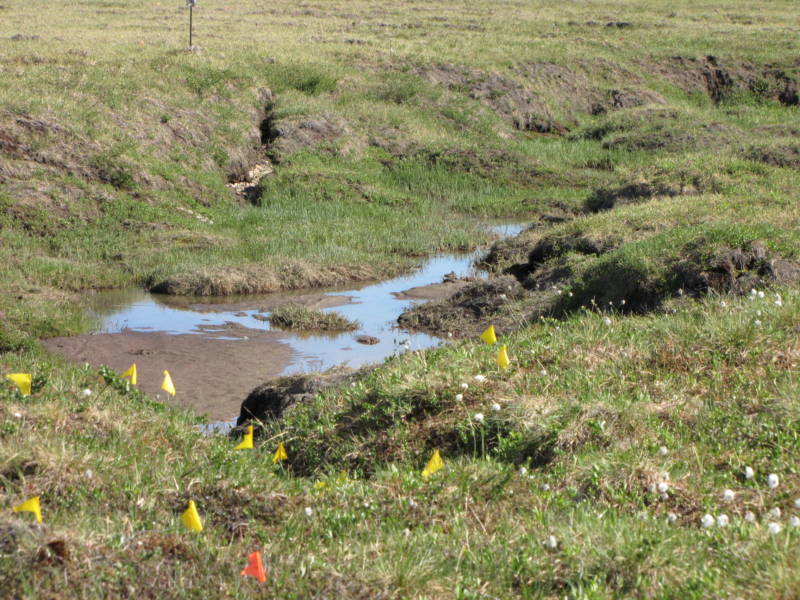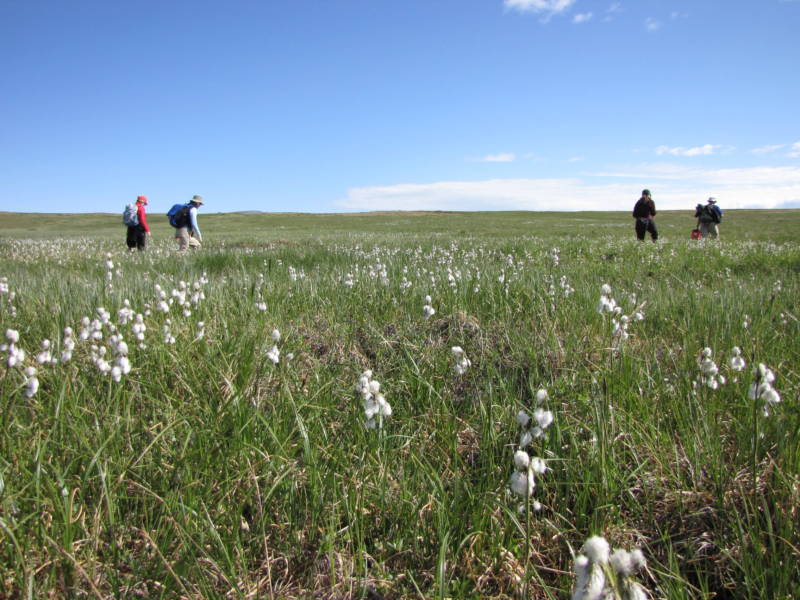
The Arctic is warming, almost twice as fast as the global average, according to a recent study. Much of the accelerated warming here is due to positive feedbacks, including one related to the loss of summer sea ice in recent decades. White surfaces, like snow and ice, reflect most of the sun’s energy and have a high albedo, while the unfrozen ocean absorbs it. This creates a feedback loop: the warmer the temperatures, the less sea ice. The less sea ice, the more heat absorbed, the higher the temperatures. (As Molly Samuel reported recently, scientists are studying albedo as it relates to California’s snowpack and water supply.)
Another concern in a warming Arctic is thawing permafrost. Earlier this week, I was out with my polar fellow colleagues measuring the depth of the permafrost here around Toolik Lake with a metal probe and a plastic ruler. In some places we measured it to be just centimeters below a thin surface layer of plant-supporting soil called the “active layer.”
According to Breck Bowden, a scientist from the University of Vermont who studies permafrost here at Toolik, the latest modeling shows that approximately half of the permafrost in the Arctic will thaw in the next 50 years. That’s significant not just for the Arctic ecosystems, but potentially for the entire planet. Scientists estimate that there’s one to two times as much carbon frozen in the Arctic soils as there is currently circulating in the atmosphere, said Bowden. The problem is that as the permafrost thaws, that carbon (mostly in the form of frozen organic matter), some of which has been frozen for thousands of years, will be processed by microbes in the soil and ultimately released into the atmosphere as greenhouse gases: CO2 and methane.
“So why should someone who is living in Alabama, or Nigeria, or the Phillippines worry about what’s going on the Arctic?” said Bowden. “Well, they should worry a lot if there’s going to be a massive amount of CO2 that gets into the atmosphere and your sea level rises or your crops fail because of changes that are related to CO2 changes globally. What happens here in the Arctic is going to affect everything on the globe.”
One indicator that the permafrost in the Arctic is already thawing is the increase in thermokarsts, which are places where the permafrost has thawed and the ground has collapsed, causing a disturbance in the landscape, and often releasing large amounts of sediment into nearby streams. Several scientists, including Bowden, study thermokarsts around Toolik Lake, and they’ve observed that the number of them is increasing.
A group of us were in the field with Bowden yesterday as he paid a visit to one of his research sites about 20 minutes up the Dalton Highway from Toolik Field Station, and a 30-minute hike across the uneven ground that defines the tundra landscape.

“The Arctic explorers uniformly and universally cursed walking on the tundra, and you can see why,” Bowden explained as we hiked. “You step on it, you break your ankle. You step between it, you break your ankle. It’s very lumpy.”
The thermokarst we hiked to was not particularly catastrophic-looking to my untrained eye. It’s a gully that’s about 300 meters long, 20 meters wide, and about five meters deep. The collapse happened in 2003, and in the subsequent years it has widened, and vegetation has grown back along its sides, giving them a gentle, convex shape. Someone like me might have hiked down one side of this thermokarst and up the other without giving it much thought.
Bowden was careful to point out that thermokarsts are a natural phenomenon. (They also have been known to occur when roads and houses are built in the Arctic without proper insulation.) But he also believes that the increase in thermokarsts observed in remote areas around Toolik is not natural.
“Thermokarsts have been going on as long as there’s been an arctic landscape, and there have been more of them when it’s warmer and fewer of them when it’s colder,” he said. “But I do firmly believe that there are more of them now than there were 20 years ago, as a consequence of warming we can document in a variety of places. The question is, why is the warming occurring?”
